Back to Blog
Top 5 Web3 Smartphones: Your Guide to Solana's Saga, HTC, and More

Eric Esposito
Apr 18th, 2023
.7 min read

For more than 60 percent of global internet users, mobile phones were the primary gateway to the Web in 2022.
While surveys suggest most people use their phones primarily for communication or entertainment, these devices play a major role in the digital economy through eCommerce sites, banking services, and fintech apps. Financial companies that tap into the convenience and prevalence of mobile phones stand to gain billions in yearly revenue.
This is why several crypto projects are developing blockchain-friendly hardware units to capitalize on the mobile market. Whoever makes a "Web3 phone" go mainstream will make crypto commonplace in contemporary culture. But what does a "Web3 phone" mean, and why would people buy them?
What is a Web3 phone?
When people see a Web3 phone for the first time, they won't notice many differences from the smartphones of modern markets. In fact, many of today's Web3 phones are Android models with familiar touchscreen designs. The difference between Web3 phones and other models lies in their internal hardware and the distinctive features they offer users.
Although every Web3 phone has different specifications, they all focus on providing users with extra security and anonymity thanks to blockchain technology. Often, Web3 phones use encryption software to prevent corporations from spying on user data, and they may double as a secure cold crypto wallet. Web3 phones also prioritize decentralized applications (dApps) rather than centrally-controlled apps like Facebook. Users should have an easier time integrating their phone's crypto wallet with decentralized finance (DeFi) dApps like Uniswap or Aave and linking to NFT markets like OpenSea and Magic Eden.
What are the benefits of a Web3 phone?
Although Web3 phones are still experimental, they promise to provide users with greater privacy than current smartphone models. Thanks to the decentralization of blockchain technology, people sometimes don't need to input as much personal data when setting up an account. Instead of entering your name and address to join a centrally controlled ecosystem, a Web3 phone provides users with a unique crypto wallet to serve as their "digital ID" on dApps. Arguably, the anonymity Web3 phones provide may reduce the privacy concerns many users have surrounding Big Tech's access to user data.
Besides their potential security benefits, Web3 phones may help democratize access to the digital economy. Since people don't need to submit data like a credit check to use DeFi, more people will have access to crypto trading, lending, and borrowing at their fingertips. The built-in features on Web3 phones might make it easier for non-crypto natives to experiment with new passive income opportunities or alternative financial services.
5 examples of Web3 phones
Let's be clear: Web3 phones are still a "niche" category. But there are a few prominent models hitting the market worthy of note.
What is the Solana Saga?
The Solana blockchain achieved massive success thanks to its rapid transaction speeds and low network fees. Since these features worked so well in the crypto community, Solana believes it could drive the mass adoption of crypto via mobile technology. To overcome the barriers of Web2-based business models, the team at Solana Labs decided to create the Solana Saga phone, which is set for pre-order on April 20, with an official launch on May 8.

Each Solana Saga uses a Qualcomm Snapdragon 8+ Gen1 processor to power a "Seed Vault," which keeps the private key for each user's crypto wallet separate from the operating system. For extra security, your seed phrase links to your fingerprint thanks to a scanner on the back of the Saga device. The Seed Vault makes it seamless to interact with DeFi, gaming, and NFT trading opportunities through the Solana dApp Store. Saga also has a mobile wallet adapter (MWA) to link with dApps currently available on a Web browser.
Overall, customers could think of the Solana Saga as an enhanced Android device with unique Web3 functionalities. Of course, people most engaged in the Solana ecosystem are the best fit for this product, but it's difficult to say whether the initial $1,000 price tag will bring in mainstream consumers. Still, thanks to Solana's dominant place in the crypto market, the Saga is one of the top contenders in the Web3 phone market.

HTC 1 Exodus
While the Solana Saga is trending high in today's Web3 phone market, the HTC 1 Exodus was one of the first to draw attention to the possibility of creating a "blockchain phone." Released in 2018, the HTC 1 Exodus is an Android device with a "Zion Vault" to keep the built-in wallet seed phrase separate from the phone's operating system. HTC 1 Exodus also introduced the "Social Key Recovery" feature to securely send a copy of your private key to trusted friends or family members in case your phone breaks.

HTC 1 Exodus is well-known for its partnership with the centralized crypto exchange Binance. People with an HTC 1 Exodus enjoy easy access to Binance's main exchange and the decentralized BNB Smart Chain.
HTC Desire 22 Pro

The Desire 22 Pro is another Web3 phone entry from Taiwan's HTC. However, unlike the HTC 1 Exodus, this newer model emphasizes virtual reality (VR) and the metaverse. With an HTC Desire 22 Pro, users can easily sync their mobile device with HTC's VIVE VR headset to experiment with immersive mixed-reality apps. This Web3 phone also has a built-in Ethereum and Polygon crypto wallet for storing and sharing crypto assets and NFTs.
Sirin Labs Finney Phone

Sirin Labs is a London-based company focused on building secure hardware devices with blockchain applications. In 2018, this company released its flagship "Finney Phone," one of the earliest mobile devices to offer a built-in cold storage wallet. Finney phone users also get access to the "dCENTER" dApp store and crypto incentives for learning about new crypto developments.
Metavertu
Vertu is already famous for its deliberately luxurious smartphone devices, and the Metavertu is no exception. This new phone bills itself as a "Web3 phone," and it seems to be targeting crypto whales with its eye-watering price tags. At $3,300 for the cheapest model, the Metavertu will only appeal to an elite clientele.

So, what's "Web3" about Metavertu phones? People who use Metavertu units get access to a cloud-based service called "Value" to create and store their in-phone crypto wallet. Vertu also claims to offer the option to run an Ethereum node, mint pictures into NFTs, and access analytics on new crypto projects. However, there are few details on the specific dApps people will have access to with this unit. Vertu seems to be more interested in catering to successful crypto investors with included 24/7 concierge service and gaudy aesthetics (including alligator leather!).
What do Web3 phones mean for NFT collectors and creators?
Web3 phones promise to make NFT minting and collecting as simple as snapping a photo or buying items on an eCommerce website. In fact, some Web3 phones like Solana's Saga let users create NFTs from pictures in their library and list them on NFT markets like Magic Eden. Plus, since these mobile phones double as hardware wallets, collectors can securely store their digital collectibles on their mobile phones.
Web3 phones may also open new incentives or passive income streams for NFT fans. For example, the Solana Saga phone has an exclusive NFT "Saga Pass," proving each token holder pre-ordered the Saga. With the "Saga Pass" NFT, people can access exclusive merchandise and discounts in the Solana ecosystem.

If Web3 phones live up to their claims, they might make collecting, creating, and displaying NFTs more attractive and accessible.
How to buy NFTs with a Web3 phone
Buying NFTs on Web3 devices isn't so different from using a desktop or "Web2 phone." Most often, Web3 phones have dApp stores where people can link their crypto wallet to NFT markets. For example, the Saga has the Solana dApp Store with access to Solana-focused NFT markets like Magic Eden.

Because each Web3 phone has a built-in crypto wallet, the process of linking and signing transactions should take less time than on current models. In the case of the Solana Saga, people can use the fingerprint tab on the back of the device to verify their identity and instantly confirm crypto transactions.
Overall, buying and selling NFTs with Web3 phones promises to be more streamlined than on current devices, and future iterations or generations of Web3 phones could ultimately succeed or even replace the web2 phones we grew so accustomed to during the twenty-teens.
Are Web3 phones the future of blockchain tech?
While Web3 phones certainly have the potential to make blockchain technology more accessible, it's too early to say whether they'll impact crypto adoption. Although devices like the Solana Saga are impressive, the current price points for Web3 phones are steep compared with dominant brands Apple and Samsung. It's probably wishful thinking for non-crypto consumers to gravitate towards more expensive Web3 phones simply because they have built-in wallets and integrations with dozens of dApps.
That said, Web3 phones open new possibilities for developers, and they help make crypto more accessible for non-tech-savvy users. If manufacturers figure out a way to make an affordable and enjoyable Web3 phone — and if crypto adoption continues to gain ground — it may impact the future of blockchain technology.
Related Posts

Fractional NFTs Explained: From Collector DAOs to PartyBid, and More
The Web3 space can be intimidating to newly onboarded mavericks. But fracti...

Virginia Valenzuela
Apr 13th, 2023

NFT Debates: Is AI-Generated Art Better Than Traditional Art?
Are AI algorithms better at art than humans alone? It's time to jump into t...

Eric Esposito
Apr 6th, 2023

Bitcoin Ordinals Explained: Pricing, What They Are, and How They Work
Launched in January 2023, Bitcoin Ordinals have made enormous waves in the ...

Virginia Valenzuela
Mar 31st, 2023